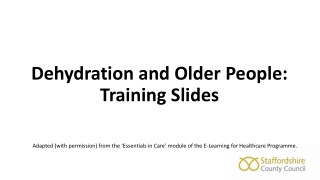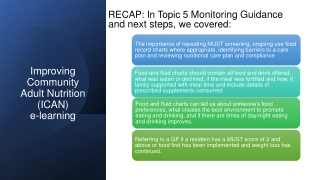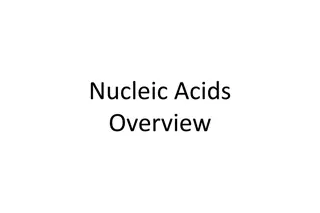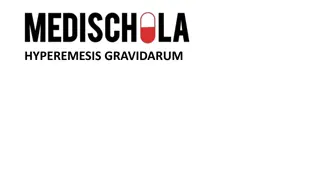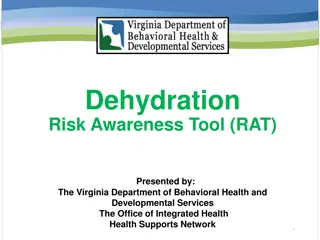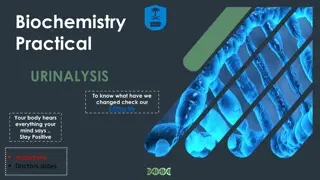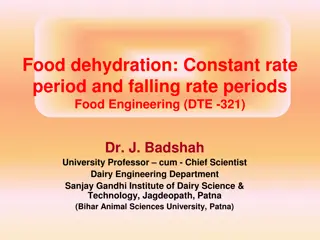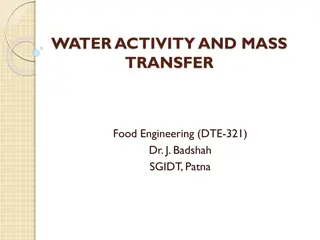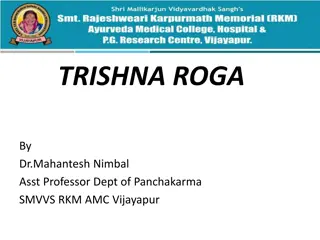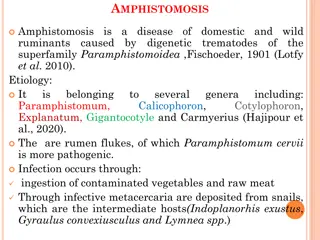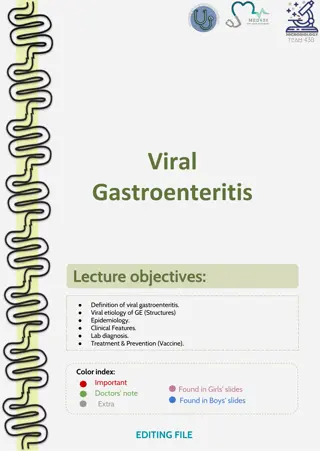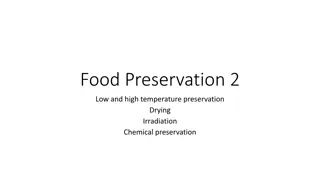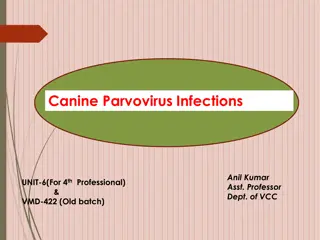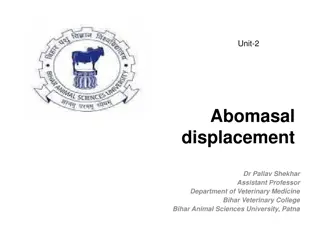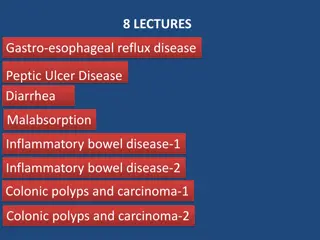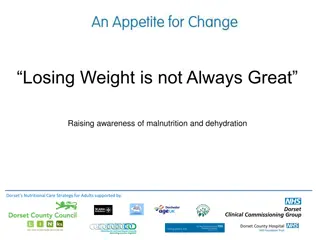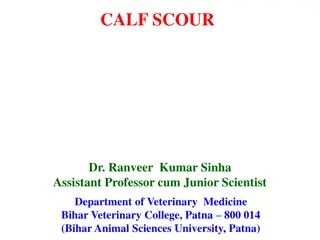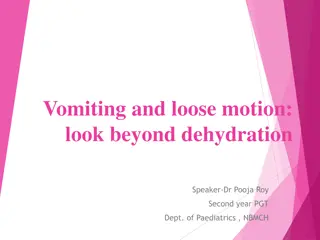Dehydration and Older People: Training Slides
Training slides adapted from the Essentials in Care module of the E-Learning for Healthcare Programme on dehydration in older people, covering the risks, signs, prevention, and the role of water.
1 views • 21 slides
Importance of Monitoring Guidance in Nutritional Care
This recap covers the significance of regular screening, using food record charts, identifying barriers to care plans, and reviewing nutritional compliance. It emphasizes the ICAN e-learning module and the key factors influencing nutritional care. The content highlights the importance of adequate fl
0 views • 16 slides
DERMATOLOGY AND RHEUMATOLOGY
Staphylococcal Scalded Skin Syndrome (SSSS) is a serious condition characterized by red blistering skin resembling burns. It is caused by toxins from Staphylococcus aureus, leading to exfoliation of the skin. Common in infants, the elderly, and immunocompromised individuals, SSSS requires prompt dia
0 views • 89 slides
Safety Focus Areas and Risk Management in Activities and Encampments
Addressing key safety focus areas such as allergies, food safety, slips, trips, falls, dehydration, and heat-related illnesses is crucial for ensuring participant well-being in various activities and encampments. Proper risk management planning, real-time assessment, and staff training are vital com
0 views • 9 slides
Nucleic Acids Overview
Delve into the intricate world of nucleic acids with a focus on DNA and RNA structures, DNA replication, RNA transcription, protein biosynthesis, cancer/chemotherapy, genetic engineering, and more. Explore the structures of bases, sugars, nucleosides, nucleotides, and parts of nucleotides, along wit
8 views • 58 slides
Understanding the Seliwanoff Color Reaction and its Significance
The Seliwanoff color reaction, discovered by Russian chemist Feodor Feodorovich Selivanov, is used to differentiate between aldoses and ketohexoses based on their dehydration and reaction with resorcinol in acidic conditions. Ketoses like fructose react faster than aldoses like glucose, leading to a
3 views • 20 slides
Understanding Hyperemesis Gravidarum: Causes, Symptoms, and Treatment
Hyperemesis gravidarum is a severe form of nausea and vomiting during pregnancy, affecting around 27% to 52% of women. The condition typically starts between the 6th to 8th week of pregnancy and is linked to hormonal changes. Risk factors include family history, obesity, and young age at pregnancy.
4 views • 10 slides
Niacinamide Night Cream For Glowing Skin
Nourish and rejuvenate your skin while you sleep with Niacinamide Night Cream. This cream Helps in Fighting Dryness and Dehydration. Shop on uniqaya.com
6 views • 6 slides
Dive into Style_ Exploring Marlei's Bikinis and Swimwear Collection
You know what that means! It's time to get out the Biknis Swimwear from storage - and some\nBeachwewar Bikni along with it. After all, it is necessary to keep cool to avoid dehydration, so\nwhy not do it in style?
0 views • 4 slides
Understanding Fluid Therapy in Veterinary Medicine
In the nineteenth century, fluid therapy was limited to severely ill patients, but now both veterinary and human medicine utilize intravenous fluid therapy extensively. Dehydration can have serious consequences, and isotonic replacement fluids are essential based on estimated dehydration, maintenanc
1 views • 20 slides
Understanding Evaporation in the Food Industry
Evaporation, a key process in the food industry, involves removing excess water from raw materials or processed foods to enhance preservation and reduce costs. It requires considerations such as heat transfer, temperature control, and prevention of overheating. Evaporation differs from dehydration a
0 views • 22 slides
Signs of Dehydration in Adults | healthcare360
This comprehensive guide explores the signs, symptoms, risk factors, prevention tips, and when to seek medical help for signs of dehydration in adults.
0 views • 4 slides
Draft Permit No. 5142M8: Willow Lake Gas Processing Facility Overview
The Willow Lake Gas Processing Facility, operated by Crestwood New Mexico Pipeline LLC, has a history of construction and operation, including the addition of compressor engines and equipment to enhance gas processing capabilities. The Draft Permit No. 5142M8 outlines proposed modifications, such as
1 views • 8 slides
Dehydration Risk Awareness Tool (RAT) Overview
The Dehydration Risk Awareness Tool (RAT) presented by The Virginia Department of Behavioral Health and Developmental Services aims to educate DSPs, caregivers, and support coordinators about the importance of recognizing, preventing, and addressing dehydration. The tool covers topics such as signs
1 views • 20 slides
Understanding Urinalysis: Importance and Interpretation of Urine Analysis Parameters
Urinalysis is a crucial diagnostic tool that provides valuable insights into various health conditions through the examination of urine physical and chemical properties. This examination helps in detecting abnormalities such as diabetes, renal failure, dehydration, and infections. By understanding t
1 views • 11 slides
Understanding Food Dehydration: Constant vs. Falling Rate Periods
Food dehydration involves constant rate periods where moisture evaporates uniformly until a critical point is reached, and then transitions to falling rate periods where drying slows down. Various drying methods and characteristics of air play crucial roles in this process, impacting the efficiency
0 views • 9 slides
Understanding Water Activity and Mass Transfer in Food Engineering
Water activity (aw) plays a crucial role in microbial activity, chemical and physical changes in foods, and the dehydration process. Maintaining water activity below specific levels can prevent microbiological spoilage and deterioration reactions, while also affecting texture, aroma, and overall qua
0 views • 11 slides
Understanding Trishna Roga: Causes, Symptoms, and Treatment
Trishna Roga, or excessive thirst, is a condition characterized by a strong desire for water due to dehydration. It can be caused by factors like vomiting, diarrhea, and excessive sweating. This article discusses the etiology, symptoms, and traditional treatment methods of Trishna Roga as per Ayurve
1 views • 19 slides
Understanding Amphistomosis in Ruminants: Causes, Symptoms, and Diagnosis
Amphistomosis is a disease in ruminants caused by several types of rumen flukes. It leads to productivity losses, weight loss, fertility reduction, and other symptoms. Infection occurs through ingestion of contaminated vegetables and raw meat. The parasite affects the rumen and reticulum of sheep, g
0 views • 8 slides
Overview of Viral Gastroenteritis: Etiology, Epidemiology, Clinical Features, Diagnosis, and Treatment
Viral gastroenteritis is an inflammation of the gastrointestinal tract primarily affecting the stomach and small intestine, leading to symptoms like acute diarrhea and vomiting. It can be caused by various infectious agents such as Rotavirus, Adenovirus, Caliciviruses, Astrovirus, Coronavirus, Torov
1 views • 7 slides
Understanding Blanching: A Key Step in Food Preservation
Blanching is a crucial pre-treatment process for vegetables and fruits in food preservation methods like canning, freezing, and dehydration. By rapidly heating the food and then cooling it, blanching helps inactivating enzymes, removing gases, brightening colors, and improving texture. This process
1 views • 17 slides
Understanding Canine Viral Infection: A Comprehensive Overview
Canine Viral Infection, caused by canine parvovirus-2, is a highly contagious disease affecting dogs, especially puppies. The infection spreads through fecal-oral route and can lead to severe clinical signs like vomiting, diarrhea, and dehydration. The virus replicates in lymphoid tissues, affecting
0 views • 11 slides
Fainting Safety: Prevention and Recognition Strategies
Fainting, medically known as syncope, is a sudden loss of consciousness that can be caused by various factors like dehydration, heat, anxiety, or low blood pressure. This presentation debunks the myth of knee-locking causing fainting and focuses on prevention strategies such as proper hydration, nut
1 views • 14 slides
Understanding Packed Cell Volume (PCV) and Haematocrit (HCT) Testing
Packed Cell Volume (PCV) or Haematocrit (HCT) is a blood test that measures the volume of red blood cells as a percentage of total blood volume. High or low values can indicate specific health conditions like dehydration or anemia. The test is important in diagnosing conditions like polycythemia. Me
0 views • 14 slides
Understanding the Effects of Skin Cleansing Products on Skin Health
Skin cleansing is essential for maintaining healthy skin, but some cleansers can lead to skin barrier damage, dehydration, and irritation. Surfactants in cleansing products can disrupt the skin's structure and impact its barrier function, potentially causing dryness, redness, and itching. Additional
0 views • 73 slides
Livestock Skillathon Quiz Questions
Test your knowledge on livestock-related topics with this quiz featuring questions on mating systems, goat dehydration, mineral balance, muscle fat intermingling, body condition scoring, swine teeth, genetic structures, nutrient requirements, and livestock terminology.
1 views • 12 slides
Understanding Intestinal Obstruction: Causes, Classification, and Pathophysiology
Intestinal obstruction can be classified into dynamic and adynamic types, with various causes such as intraluminal faecal impaction, malignancy, and hernia. The pathophysiology involves changes in bowel peristalsis and dilation, leading to potential strangulation and ischemia. Morbidity and mortalit
9 views • 40 slides
Enhancing Emergent Care in Athletic Training: Intravenous Therapy Overview
This presentation discusses the role of intravenous (IV) therapy in athletic training, focusing on sport-related causes for IV fluid replacement, patient signs and symptoms necessitating IV therapy, proper application of angiocatheter insertion, and regulatory considerations. It highlights the impor
0 views • 32 slides
Understanding Specimen Preparation in Electron Microscopy
Living things cannot survive in an electron microscope due to the high temperature generated by the electron beam, vacuum inside the microscope, and need for specimen preparation steps like fixation, dehydration, freezing, cutting, and mounting. Fixation involves stabilizing tissue with chemicals, d
3 views • 10 slides
Understanding Abomasal Displacement in Dairy Cattle: Causes, Symptoms, and Management
Abomasal displacement is a common issue in older lactating dairy cattle, often related to inadequate nutrition and concurrent diseases. This condition involves the displacement of the abomasum from its normal position, causing symptoms like anorexia, ketosis, and dehydration. Learn about the causes,
1 views • 21 slides
Understanding Hyperemesis Gravidarum: Symptoms, Complications, and Management
Hyperemesis gravidarum is a severe condition in pregnancy characterized by intractable nausea and vomiting, resulting in fluid and electrolyte imbalances, nutritional disturbances, and physical and psychological debilitation. The exact cause is unknown, but factors like hormonal changes, genetics, a
0 views • 22 slides
Understanding Diarrhea: Causes, Classification, and Significance
This informative content delves into the physiology of fluid in the small intestine, defines diarrhea, and outlines its various types and common causes. It emphasizes the importance of addressing diarrhea promptly to prevent dehydration and electrolyte imbalances, especially in children, as it remai
3 views • 52 slides
Nutritional Guidance for Children with Health Challenges
This presentation by Maria Raspolic, MS, RD discusses common nutritional issues in children with health challenges, providing recommendations to address these issues and exploring the use of the ketogenic diet for seizure management. Topics cover poor growth, dehydration, constipation, inadequate nu
0 views • 29 slides
Acute Malnutrition - Fluid Management and Treatment Overview
Acute malnutrition, particularly severe acute malnutrition (SAM), requires careful fluid management and a structured treatment approach involving stabilization, transition, and rehabilitation phases. This condition results from inadequate dietary intake or acute infections, leading to severe wasting
0 views • 23 slides
Understanding the Impact of Malnutrition and Dehydration on Adults
Raising awareness on the risks of malnutrition and dehydration in adults, Dorset's Nutritional Care Strategy highlights the prevalence, causes, and consequences of unintentional weight loss. By shedding light on the alarming statistics and factors contributing to malnourishment, this initiative aims
0 views • 11 slides
Understanding Chronic Diarrhea: Causes and Consequences
Chronic diarrhea is characterized by persistent loose, watery stools lasting more than 14 days. The condition can be caused by various factors such as osmotic, secretory, inflammatory, or motility disorders. In developing countries, it often follows acute infections, while in developed countries, un
0 views • 71 slides
Mountain Maladies: How to Prevent and Manage Common Outdoor Health Risks
Explore the risks of outdoor activities, from dehydration to hypothermia, and learn how to identify symptoms and take preventive measures. Discover the importance of staying hydrated, recognizing heat exhaustion, and preventing hypothermia by dressing appropriately and avoiding wet conditions.
0 views • 17 slides
Understanding Diarrhea: Causes, Symptoms, and Pathophysiology
Diarrhea is a common symptom that can be caused by various factors such as viral, bacterial, parasitic infections, dietary changes, drugs, systemic diseases, and intestinal obstructions. It can lead to dehydration and other serious complications if not treated promptly. The pathophysiology of diarrh
0 views • 15 slides
Understanding Calf Scours: Causes, Symptoms, and Treatment
Calf scours, a prevalent disease in cattle, can lead to severe dehydration and health issues if left untreated. It is not a single disease but a clinical sign of various underlying causes. Identifying symptoms, such as diarrhea and dehydration, and providing timely treatments like fluid therapy and
0 views • 10 slides
Pediatric Case Study: Vomiting, Dehydration, and Ambiguous Genitalia in a 3-Year-Old Child
A 3-year-old child was admitted with severe dehydration due to persistent vomiting, alongside failure to thrive. Despite treatment, hypotension remained unresolved. Examination revealed ambiguous genitalia with clitoromegaly and absent gonads. Investigations showed electrolyte imbalances and hormona
0 views • 16 slides
